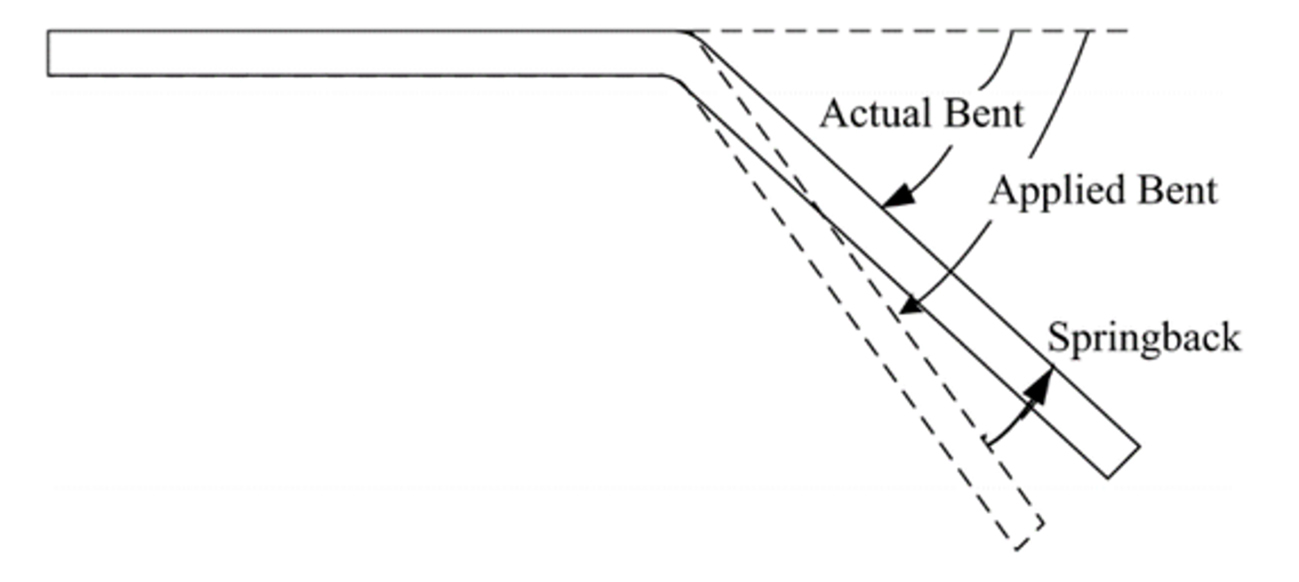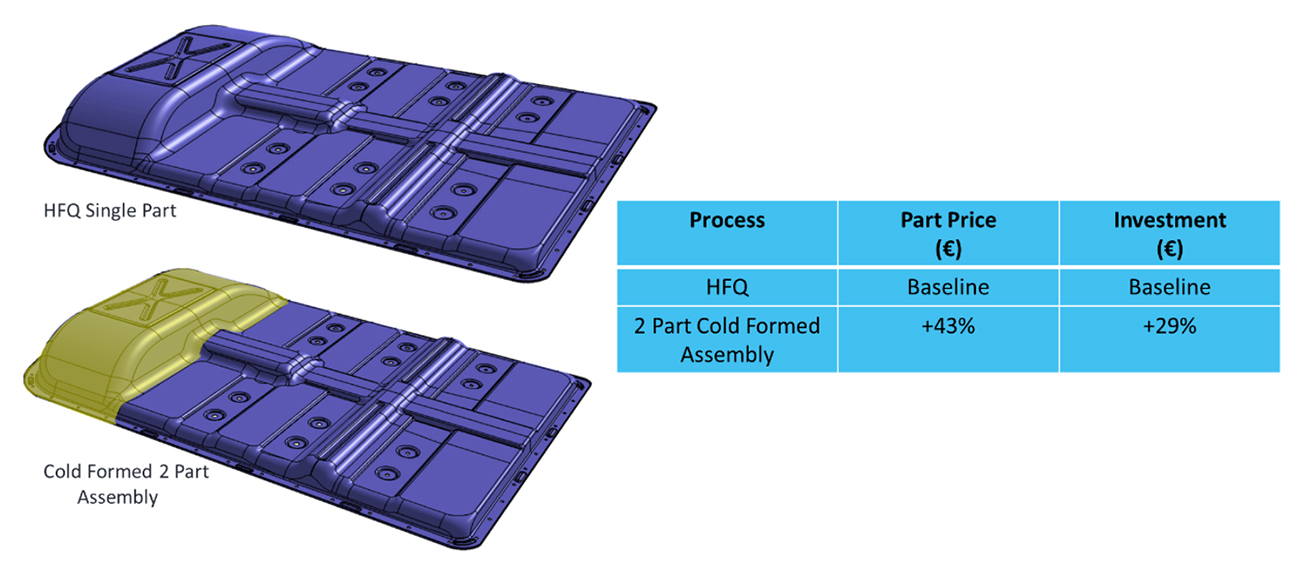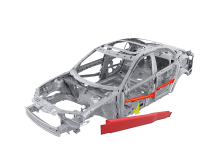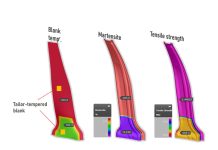Introduction
 Cold forming of aluminum has been in use for several decades, but its capabilities constrain the products it can create. This process restricts design flexibility, as complex parts must be divided and formed individually before being assembled later.
Cold forming of aluminum has been in use for several decades, but its capabilities constrain the products it can create. This process restricts design flexibility, as complex parts must be divided and formed individually before being assembled later.
By forming at elevated temperatures after solutionizing, hot forming overcomes many disadvantages of the cold forming process. In this article, we will explore the key advantages of hot forming over other methods.
Why Do We Need Hot Form Quench?
The hot form quench (HFQ) process offers many advantages over traditional aluminum forming processes. Designs that were previously impossible with cold forming become achievable with HFQ. Let’s explore some of the key reasons why most aluminum forming plants would benefit from adopting HFQ.
High Formability
One of the primary benefits of HFQ is its high formability. It allows us to expand our design possibilities, enabling the creation of complex part designs in a single stage from a single blank. For instance, some aluminum deep-drawn door inners cannot be formed from a single cold formed blank, requiring two or three pieces to be made separately and then assembled.
With HFQ, the same part can be formed in a single stage from a single blank, eliminating the need for assembly operations and extra tools. This approach also reduces part costs and improves material utilization.

Fig. 1: (left) cold vs. HFQ hot formed.
We can also consider the example of an aluminum door ring, which is often difficult to form cold and typically requires multiple assembled panels and press tool operations. HFQ has recently enabled the production of extremely complex production door rings in a single draw operation from a single blank, while simultaneously achieving high strength in the final part to improve the vehicle’s side impact performance
The Use of Ultra-High-Strength Aluminum
HFQ can leverage the benefits of ultra-high-strength aluminum. When we use cold forming to form ultra-high-strength aluminum, we encounter challenges such as high springback, the inability to form sharp radii, reduced drawing depth, dimensional inconsistencies, and a high risk of fracture. These issues sometimes lead manufacturers to opt out of using aluminum, although they can be avoided altogether by switching to HFQ.
The main benefit of ultra-high-strength aluminum is downgauging. Strength-driven applications such as A-pillars and B-pillars can be downgauged, resulting in lower vehicle weight. Lower weight reduces cost, improves sustainability, and decreases operating expenses.
The ability to use ultra-high-strength aluminum has been a crucial factor in many manufacturers choosing HFQ over other processes.
Negligible Springback
One of the largest obstacles to developing a feasible forming process is springback. Predicting and controlling springback is a major challenge in forming processes.
As we move from low to higher strengths of aluminum, springback increases, impacting the accuracy of the final product. Manufacturers must develop compensation strategies, either through simulation or physical trial and error, involving lengthy tryouts to manage springback.
Excessive springback in parts may be addressed by re-engineering the part or performing tool recuts, both of which are costly and time-consuming solutions.

The HFQ process, which occurs at high temperatures, results in minimal springback compared to cold forming. The final part does not retain residual stresses, allowing for precise dimensional control and repeatability, even with downgauging and ultra-high-strength aluminum.
Manufacturers no longer need to struggle with compensation strategies or re-engineering parts when opting for ultra-high-strength aluminum grades.
The resource savings and associated benefits are enormous, as multiple tryouts and tool recuts are one of the reasons for project delays and loss of reputation.
Tool Cost Reduction
The HFQ process can eliminate the need for press tooling and assembly tooling depending on the application, reducing the substantial tooling investment, which is typically a significant cost factor in manufacturing.
In one instance, HFQ technology replaced high-pressure die casting, resulting in a 60% reduction in overall tool costs, along with a 35% weight reduction.

Fig. 2: Cost reduction compared.
The Natural Next Step in Aluminum Hot Forming Evolution
Aluminum is highly recyclable, with almost 75% of all aluminum ever produced still in use today. Unlike aluminum, steel can only be recycled a limited number of times before degrading. Additionally, aluminum production consumes less energy and emits fewer greenhouse gases compared to steel.
Through HFQ, original equipment manufacturers (OEMs) can achieve their sustainability goals while staying within budget.
HFQ Process Onboarding for Organizations
HFQ Technology Associates now holds exclusive IP rights for the HFQ process. To facilitate the integration of HFQ into manufacturing facilities for new OEMs, they have established a strong global network of suppliers and partners.
Support from HFQ Partners and Suppliers
This network enables them to offer complete systems solutions to OEMs. The HFQ process allows for the repurposing of facilities like boron steel lines. Alternatively, OEMs may opt to install new lines through toolmakers and press manufacturers within the partner network.
HFQ Technology Associates collaborates with partners and OEMs to transfer knowledge and technology related to tooling, automation, press manufacturing, and other areas.
Direct Support from HFQ Technology Associates
HFQ Technology Associates offers seminars, training, design guidelines, and body design reviews to assist new OEMs struggling to use HFQ reliably.
The body design review identifies optimal locations in a structure for using HFQ. HFQ Technology Associates offers forming simulation to assess part feasibility before an organization commits to tooling, helping determine which parts would benefit from HFQ.
The goal is to find parts that could use ultra-high-strength aluminum or parts that could be combined to reduce assembly steps. The final result ensures reduced weight and stronger components like A-pillars, B-pillars, and upper structures. Research by a major OEM indicated that switching to HFQ 6000 series from cold-formed 5000 and 6000 series in body-in-white structures could achieve up to 20% weight savings.
If the organization chooses to use HFQ, HFQ Technology Associates can provide training for the engineering team and license patented technology for in-house forming simulations.
To Sum it Up
With HFQ, manufacturers now have a reliable method to incorporate ultra-high-strength aluminum in their products. Advanced simulation guarantees accurate designs from the start, with the additional benefit of eliminating springback.
The process helps OEMs achieve their carbon reduction goals without sacrificing product quality or budget. HFQ can also utilize 100% recycled aluminum, significantly reducing the carbon footprint of automakers.













